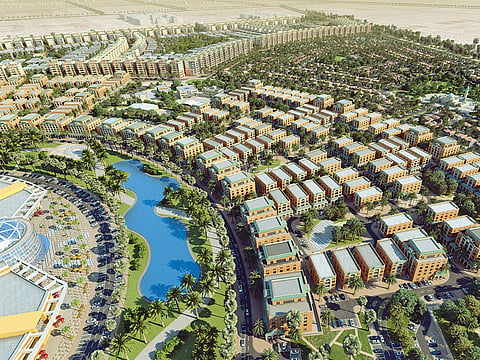Sharjah in the spotlight
Emirate positioning itself as affordable entry point into UAE real estate market

Long considered a third option farther down the road from the more popular real estate hotspots of Dubai and Abu Dhabi, Sharjah could well be on par with its neighbours as among the most desired destinations for property investment in the Middle East and North Africa (Mena). The game changer for Sharjah’s property market, according to Faisal Durrani, head of research at Cluttons, was a new law introduced in 2014 that allowed expats in the UAE to acquire property in designated areas, starting with Tilal City.
“At the end of 2014, 1,800 mixed-use plots went on sale and while the majority of buyers have been Emirati, purchasers from Syria, Pakistan, Palestine and Kuwait also feature prominently,” says Durrani.
With the new law, Sharjah has essentially become an affordable entry point into the UAE property market. In a Cluttons survey before the summer, Sharjah was in fourth place behind Istanbul as the region’s most desired real estate investment destination. “I’d not be surprised if at this point it would be Dubai, Abu Dhabi and Sharjah as the most preferred,” says Durrani. “In these three cities, there is a diverse range of residential and commercial property options.”
The emirate is equally popular with affluent investors. “Sharjah continues to surprise with its higher-than-expected profile among the region’s wealthy property investors as demonstrated by its third-place ranking within the GCC, behind Dubai and Abu Dhabi, in our 2016 Middle East Private Capital Survey,” says Durrani.
In the first half of the year, the total value of real estate investments in Sharjah amounted to Dh12.1 billion from a total of 1,860 sales transactions, according to Asteco’s Q3 2016 Northern Emirates Real Estate report, quoting figures from the Sharjah Real Estate Registration Department (SRERD). The report states that average rents in Sharjah are still 38 per cent cheaper than in 2008, as additional supply keeps rates from increasing rapidly. However, the market is relatively stable with rents in low and mid-range properties seeing minimal changes in the third quarter, down by only 1 per cent compared with the previous quarter.
John Stevens, managing director of Asteco, says that Sharjah’s property market is still influenced by pricing trends in Dubai, where rental rates are currently balancing out, resulting in a slowdown in movement of residents between the two emirates. The Cluttons report concurs, noting that Sharjah’s residential rental market has been tracking the Dubai market for almost two years now. Rates in Dubai are down 8 per cent compared to the same period last year, according to Cluttons, while Sharjah saw a year-to-date decline of 7.1 per cent.
However, Sharjah has maintained, if not strengthened, its edge as a favourite location for those seeking quality housing at affordable prices. And now with more quality choices entering the market, Cluttons notes that many Sharjah landlords have been forced to lower rents or offer more incentives. “Despite the ongoing correction, average rents in Sharjah are still 30 per cent higher than they were at the start of 2012, highlighting the strength of rent rises in recent years,” says Suzanne Eveleigh, property management director at Cluttons. “Still, Sharjah’s rents remain at almost half the levels seen in Dubai or Abu Dhabi, with one-bedroom flats in Sharjah renting out for roughly Dh41,000 per year, compared to over Dh100,000 per year in Dubai or Abu Dhabi.”
Durrani says rents could end up dropping an average 10 per cent by the end of the year, in line with Cluttons’ projections, and could likely fall by 5-7 per cent next year “before things stabilise”.
According to Asteco, on average rents in new developments in Sharjah range from Dh20,000-Dh35,000 for a studio and Dh45,000-Dh90,000 for a three-bedroom unit. In Al Majaz, rents range from Dh25,000-Dh35,000 for a studio, while three-bedroom apartments are available from Dh48,000-Dh90,000. Prices in the Corniche area start from Dh26,000 to Dh35,000 for a studio, while three-bedroom apartments range from Dh60,000-Dh95,000.
Buyer’s market
New supply coming into the market is one of the main reasons cited why prices remain low. New residential supply was announced in Sharjah by Al Thuriah, who launched Sahara Tower 6 at Cityscape Global in September. The residential tower is part of the Sahara Complex, which is a master development with a built-up area of 3.1 million sq ft and has 1,348 apartments. The new project will have 376 residential units to be handed over in the fourth quarter of 2019.
New master-planned communities have been announced as well, which reflects a strong appetite for Sharjah real estate despite a general UAE-wide slowdown in the property market. “Demand for a slice of Sharjah’s emerging master-planned land market remains high and continues to exceed expectations,” the Cluttons report states. Durrani adds: “Further property investment opportunities in the form of additional gated community developments point to a bright future for the emirate’s rapidly emerging property market profile.”
Asteco, citing SRERD data, notes that a large majority of real estate transactions (89.5 per cent) were concluded in Sharjah’s city areas such as Al Khan (240 transactions), Al Majaz 3 (173), Sajaa Industrial Area (159), Al Nahda (111) and Muwaileh Commercial District (105). The remaining 877 transactions were in other areas of the emirate.
Commercial and retail
There is also a steady delivery of new commercial and retail supply, even as office rents have dropped, making the emirate more affordable. Similar to the residential market, office rents in Sharjah have also tracked commercial rents in Dubai.
Cluttons explains that office rents in Sharjah have succumbed to pressure from falling rents in some of Dubai’s most affordable submarkets such as Jumeirah Lakes Towers, where rents start at Dh60 per square foot. Rents in the prime areas of Al Majaz have fallen by Dh10 between January and September, while rents in Al Soor have held firm at Dh60 per square foot.
Sign up for the Daily Briefing
Get the latest news and updates straight to your inbox



